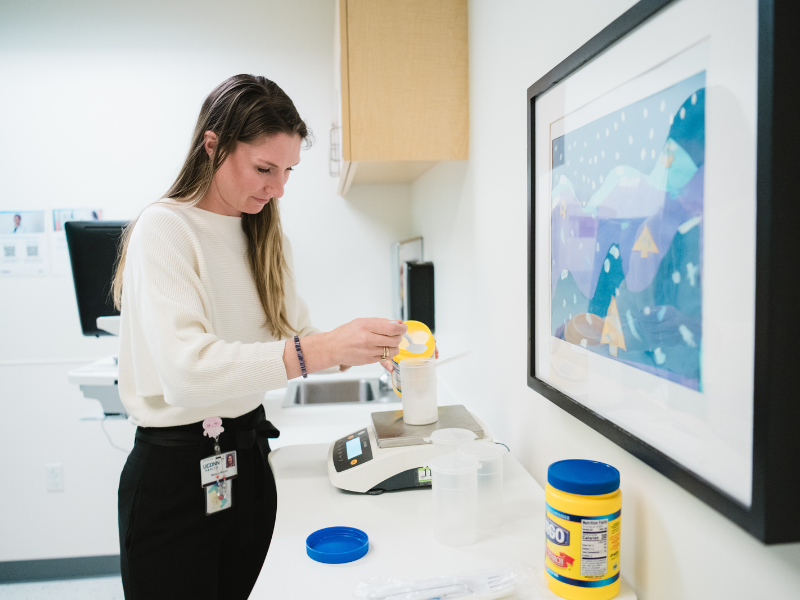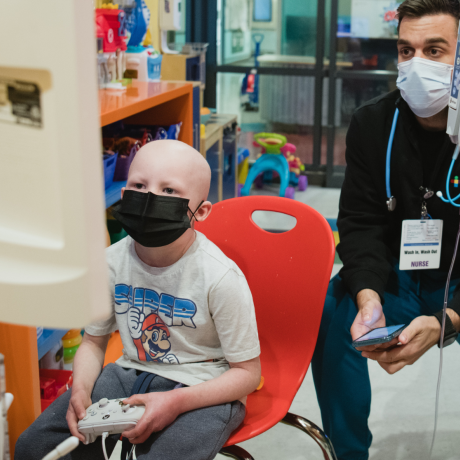Connecticut Children’s Senior Research Dietitian Malaya Mount is looking for answers
Imagine having a child who needs to drink uncooked cornstarch mixed with water every three to four hours, around the clock, in order to keep them alive. You get up throughout the night to make sure they haven’t slept through the multiple alarms they’ve set, because there is only a five-minute margin of error in the schedule. You worry every day that they won’t make it in time to the nurse’s office at school. Now imagine that your child will have to do this every day, for the rest of their life.
This is life with glycogen storage disease type 1a (GSD1a), a rare metabolic disorder that affects 1 in 100,000 people. Malaya Mount, MS, RD, is part of an internationally recognized team of researchers at Connecticut Children’s and the University of Connecticut who are working to improve the lives of individuals with GSD1a—and to revolutionize treatment for patients around the world.

GSD1a is an eating disorder waiting to happen
If it sounds like an unpalatable diet, well, it is. For a patient with GSD1a, 50 to 70% of their daily calories come from cornstarch. It’s a strict regimen that keeps them alive, but also impacts their relationship to food and hunger cues. That’s where Malaya comes in. She’s a Senior Research Dietitian in Connecticut Children’s renowned Glycogen Storage Disease Program in Farmington. “With glycogen storage disease treatment, we kind of teach them to have this disordered eating pattern for their safety,” she said.
Cornstarch keeps a patient’s blood glucose levels stable and is “filling,” but it otherwise has no nutritional value. As a result, patients with GSD1a struggle with hunger cues, oral aversions, and maintaining a normal weight. It’s a perfect storm of disordered eating.
“Their relationship with food is incredibly difficult. Because cornstarch accounts for so much of their daily calories, there’s a very small window of caloric intake that we can use for actual food and nutrition,” Malaya added. “It affects their enjoyment of food.”
A female adolescent whose extreme calorie restriction and over-exercising led to a diagnosis of anorexia nervosa. She was initially referred for mental health treatment, but when her weight loss and hypoglycemic episodes continued, she was admitted to the intensive care unit due to life-threatening lab results. Nutritional management of an eating disorder is counter to the management of GSD1a, so the traditional inpatient eating disorder pathway required modification to treat her in the hospital.
Once her condition was stable and no longer as acute, she needed further inpatient eating disorder treatment, but because GSD is such a serious rare disease, she didn’t qualify for these programs. Ultimately, she enrolled in an intensive outpatient program; however, traditional eating disorder therapy worsened her GSD control and enlarged her liver. It took collaboration between psychology, adolescent medicine, endocrinology, and the eating disorders program to continuously adjust and balance her treatment for both anorexia and GSD.
We are grateful for the longstanding, generous support of the Temkin Family, who founded the Global Center for Glycogen Storage Disease.
Latest Articles

For Good: The Everyday Magic of Child Life Specialists

Hyundai Hope on Wheels Supports Connecticut Children’s with $400K Research Grant and $100K PJ Day Sponsorship
